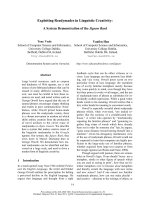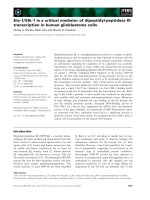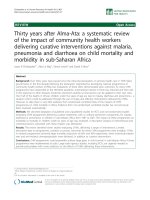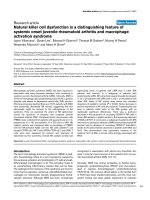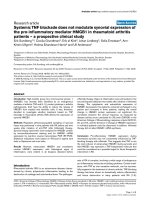Báo cáo y học: "Are acupoints specific for diseases? A systematic review of the randomized controlled trials with sham acupuncture controls" pdf
Bạn đang xem bản rút gọn của tài liệu. Xem và tải ngay bản đầy đủ của tài liệu tại đây (194.12 KB, 5 trang )
EDIT O R I A L Open Access
Semantic Web for data harmonization in Chinese
medicine
Kei-Hoi Cheung
1*
, Huajun Chen
2
Abstract
Scientific studies to inve stigate Chinese medicine with Western medicine have been generating a large amoun t of
data to be shared preferably under a global data standard. This article provides an overview of Semantic Web and
identifies some representative Semantic Web applications in Chinese medic ine. Semantic Web is proposed as a
standard for representing Chinese medicine data and facilitating their integration with Western medicine data.
Background
Asthescientificevidenceforthepreventiveandthera-
peutic efficacy of Chinese medicine (CM) is growing, it
is strongly demanded to bridge CM with Western medi-
cine (WM), particularly through the data obtained from
biomedical and clinical research. For example, there
were acupuncture studies on certain diseases/disorders
such as chronic pain [1,2] and cerebral palsy [3], on
pharmacological, molecular and therapeutic properties
of various Chinese herbs [4,5] using high-throughput
technologies such as DNA microarray and mass spectro-
metry [6,7]. Technical challenges include not only the
increasing amount of CM literature but also the wide
variety of data among various databases. Some represen-
tative databases are as follows:
i) TCMGeneDIT [8] is a database containing dis-
ease-gene-herb associations as the results of m ining
the biomedical literature;
ii) Phytochemical databases of Chinese herbal consti-
tuents were constructed [9];
iii) ClinicalTrials contains
information of a large collection of clinical trials
including those that involve CM;
iv) MedlinePlus />plus/[10] developed by t he United States National
Library of Medicine provides consumers and health
professionals with research information which covers
certain herbal supplements;
v) TCM Online http://cowo rk.cintcm.com/engine/
windex1.jsp consists of over 40 categories of CM
Databases such as the Traditiona l Chinese Medical
Literature Analysis and Retrieval Database, Clinical
Medicine Database, Traditional Chinese Drug Data-
base, Database of Chinese Medical Formula, Tradi-
tional Chinese Medicine Enterprises and Productions
Database, and State Standards Database.
Data mining and integration of CM and WM data-
bases are of great value but problematic [9,11]. Data
mining and integration problems include heterogeneity
in data formats and structures as well as a lack of stan-
dard terminology. Cultural and linguistic differences
further complicate data integration. In the informatics
community, methods developed for dat a integration can
be categorized into: (1) dat a warehousing to translate
data and (2) query federation to translate query. Both
approaches have their pros and cons. For example, the
data warehousing approach has good query performance
as data are queried locally, but data are not alway s up-
to-date (data updates a re to be made periodically to
keep the ware house in synchrony with the member data
sources). The query federation approach guarantees data
to be up -to-date, but it may suffe r from query perfor-
mance especially when large volumes of data are queried
and joined over the network. Despite their difference s,
these approaches are based on a common data model.
The use of such a model is feasible in either a single
enterprise or a small group of enterprises. A common
data model which can overcome national, geographical,
and cultural boundaries would be different w ithout a
global data representation standard. To this end,
* Correspondence:
1
Yale Center for Medical Informatics and Departments of Anesthesiology and
Genetics, School of Medicine, Computer Science Department, Yale University,
New Haven, CT 06510, USA
Cheung and Chen Chinese Medicine 2010, 5:2
/>© 2010 Cheung and Chen; licensee BioMed Central Ltd. Th is is an Open Access article distributed under the terms of the Creative
Commons Attribution License (http://cr eativecommons.org/licenses/by/2.0), which permits u nrestricted use, di stribution, and
reproduction in any medium, provided the original work is properly cited.
Semantic Web [12] has the potential to help realize data
harmonization in CM.
Semantic Web and its applications in Chinese
medicine
Semantic Web is an e volving extension of the W orld
Wide Web in which the semantics of information and
services on the Web are defined, m aking it possible for
the Web to “understand” and answer queries in accor-
dance with the Web content. SW’ s enabling technolo-
gies include the Uniform Resource Identifier (URI)
and Resource Descrip-
tion Framework (RDF) which
are the Semantic Web standards for data identification
and d ata representation respectively. The RDF provides
a “triple” format for representing a statement that con-
sists of a subject, property and object. Each component
of the triple is identified by a URI that serves as a global
unique identifier for the Web. For example, the follow-
ing triple (statement) asserts that a n herb-derived drug
“ Huperzine A” (subject) “ inhibit” (property) “NMDA
receptor” (object).
Subject – />Property – />Object – />The above example demonstrates that the Wikipedia
URIs are used to identify and define the subject, prop-
erty and object (this is onlyfordemonstrationpur-
poses). The statement indicates an “inhibitory” effect of
the drug “Huperzine A” on “ NMDA Receptor” (drug
target). A collection of linked RDF statements forms a
directed acyclic graph (DAG). Such collections of state-
ments represent the knowledge of a domain. To query
and manipulate RDF statements, we may use “SPARQL”
which is the
RDF q uery language standard. SPARQL is analogous to
SQL ki/SQL for querying rela-
tional databases.
To capture richer data semantics to support computa-
tional inferenc e and reasoni ng, the RDF Schema (RDFS)
and the Web Ontol-
ogyLanguage(OWL) />tures/ have been used to encode ontologies in the
biomedical domains [13,14]. RDFS provides the rdfs:
Class construct to declare a resource as a class, e.g.
Herb. A hierarchy of classes can be defined using the
rdfs:subClassOf construct. For example, “Huperzia ser-
rata” is a subclass of “Herb”. Most of the RDFS compo-
nents are included OWL, which is more expressive than
RDFS. OWL has the built-in property owl:sameAsthat
allows a synonymous relationship between two classes
(e.g. “Huperzine A” and “Huperzia serrata”). Cardinalit y
constraints can be applied to properties (e.g. the “inhi-
bit”
property can have a minimum cardinality of one
and cardinality with a maximum of a positive integer).
While OWL is semantically richer than RDF or RDFS, it
can be expressed using the RDF syntax. OWL reasoners
such as Pellet [15] and Racer [16] can be used to make
inferences out of OWL ontologies.
Adoption of the Semantic Web has been signif icantly
important to health care and life sciences. In part, the
adoption has been driven by the World Wide Web Con-
sortium (W3C), whi ch launched the Semantic Web for
Health Care and Life Sciences Interest Group (HCLS
IG) T he group has
been chartered to develop, adopt, and support the use
of Semanti c Web technologies and practices to improve
collaboration, research and development in health care
and the life sciences.
As RDF/OWL-fo rmatted datasets are growing in
terms of the number and size , efficient data storage
and manipulation become big issues. To this end, a vari-
ety of triplestore technologies have emerged, including
Virtuoso Oracle http://
www.oracle.com/technology/tech/semantic_technologies,
AllegroGraph and
Sesame While some of these
technologies (e.g. Oracle and Virtuoso) are proprietary,
others (e.g. Sesame) are open source. Some of them (e.g.
Virtuoso, AllegroGraph and Sesame) support SPARQL,
but some others (e.g. Oracle) have their own RDF query
languages. To provide a uniform query access, many tri-
plestores provide a so-called “ SPARQL endpoint” so
that queries can be issued by client programs against
the triplestores via the SPARQL language. For example,
even though Oracle does not support SPARQL intern-
ally, it can be configured to provide an external
SPARQL endpoint through the Jena adaptor http://
www.oracle.com/technology/tech/semantic_technolo-
gies/htdocs/doc umentation.html. Triplestores such as
Oracle provide their own native OWL reasoners, while
some others (e.g., Sesame) can be integrated with exter-
nal reasoners.
Linked Data [17] is a new method of exposing, shar-
ing, and connecting data via dereferenc eable HTTP
URI’s on the Semantic Web. A dereferenceable HTTP
URI serves as both an identifier and a locator. The key
idea is that useful information should be provided to
data consumers when its URI i s dereferenced. Using the
Linked Data approach, not only do data providers make
their data ava ilable in the form of RDF graphs, but data
linkers can also create new RDF graphs that consist of
links between independently developed RDF graphs pro-
vided by different sources. Examples of Linked Data, e.g.
DBpedia are listed
on Linking Open Data (LOD) />SweoIG/TaskForces/CommunityProjects/LinkingOpen-
Data. A similar e ffort has been launched by the Linking
Cheung and Chen Chinese Medicine 2010, 5:2
/>Page 2 of 5
Open Drug Data task force of the HCLS IG to use the
linked data approach to link drug-related data.
As the relational database technology is prevalent in
thehealthcareandlifesciencedomains,manyofthe
CM databases are currently in the relational format.
While these relational databases serve the specific needs
of individual labs or institutions, their accessibility by
other labs or institutions is limited. An object or data
record is identified by a unique identifier (primary key)
that is local to the database. In other words, the same
identifier does not identify the same object (data
records) in differ ent relational databases. Another issue
with the relational databases is that relationships are
defined based on links between primary and foreign
keys.Theselinksarenottoconveysomemeaning
semantically. Semantic Web can be used to address this
problem by allowing a seman tic layer to be created on
top of existing relational databases. Semantically rich
queries (based on meaningful relationship names) can
be formulated at the semantic l ayer (built using the
Semantic Web technology) and then be mapped to the
local queries against the underlying relational databases.
DartGrid [18] is a system demonstrating the use of this
semantic web approach to integrate CM databases. The
advantage of this approach is that existing relational
databases and applications accessing these databases
need not be abandoned, while new powerful applications
can be developed to make use of the Semantic Web
features.
As data are increasingly available in RDF/OWL for-
mat, new warehouses and federated query systems have
been built from scratch using Semantic Web technolo-
gies to allow direct acc ess by programs. As part of the
HCLS IG effort, a subset of TCMGeneDIT was con-
verted into RDF format and loaded into an RDF triples-
tore [19]. In addition, the BioRDF task force of the
HCLS IG has undertaken the effort of impleme nting
query federation using the Semantic Web [20].
Ontologies encoded by Semantic Web enable expres-
sive knowledge representation, integration, and discov-
ery. Ontology research is active in the biomedical
informatics community. Examples include the OBO
Foundry [21] and BioPortal [22] that provide access to a
large collection of biomedical ontologies. These ontolo-
gies are relevant to CM research especially when relat-
ing CM to WM. In addition, efforts have begun to
create new ontologies specifically for CM. For example,
China Academy of Traditional Chinese Medicine has
created a CM ontology that defines more than 8,000
classes and over 50,000 instances and may help integrate
heterogeneous and disparate databases [23].
Some information technologies such as text mining,
Grid computing, and Web services have been using t he
Semantic Web. These technologies combined with the
Semantic Web can further empower CM rese archers to
carry out in silico research.
Discussion
Given the long history of CM, most of the CM docu-
ments were written in Chinese. While the Web is multi-
lingual, a simple literal translation, however, is not
sufficient in terms of making the CM knowledge acces-
sible by Western researchers. An example is the transla-
tion o f signs and symptoms between CM and WM. For
example, the term Re (which literally means “Heat”)in
CM may be referred to as high fever and irritability in
WM. T he theories behind WM and various CM can be
fundamentally different, leading to the difficulty to make
alignments among their domain ontologies. For exam-
ple, CM practitioners interpret human body and organs
based on Chinese philosophical ideas of “yin-yang” and
“five-elements”. They are aware of the efficacy of the
herb, Huperzia serrata (HS), in aging disorders, and
interpret the action mechanism of this herb as strength-
ening the Shen (kidney). Biomedical scientists analyze
some experimental evidence, and deduce that a c om-
pound of the herb HS acting on the brain can serve as a
potential therapy for the Alzheimer ’sdisease.Inthis
case, HS targets the brain (WM) instead of the Shen
(kidney).
These language gaps limit the communication and
interaction between WM and CM in both directions.
On the one hand, scientific communities have not
reached the full potential of utilizing CM knowledge.
On the other hand, best practices of WM are not widely
adopted in the regions where CM is predominant form
of healthcare service. To bridge these gaps, we need to
establish an infrastructure that can support communica-
tion and collaboration in integrative medicine studies.
Theinfrastructureshouldalsobeabletocaptureand
publish the r esults of these integrative medicine studies
to extend the actionable knowledge shared among
communities.
Data sharing is a key to advancing science in the digi-
tal age [24]. For example, the Human Genome Project
[25] made public release of data to the scientific com-
munity. This open access culture should be widely
encouraged and s upported by the CM community. At
the same time, we need to address the concerns of shar-
ing data. Among these concerns is the intellectual prop-
erty including data ownership, attribution, and licensing.
The legal complication should never be underestimated,
as the laws affecti ng data sharing vary from one country
to another. The Consortium for Globalization of Chi-
nese Medicine was formed
to promote data sharing as well as collaboration among
academia , industry and regulatory agencies in various
countries.
Cheung and Chen Chinese Medicine 2010, 5:2
/>Page 3 of 5
While the Semantic Web is a cand idate for standar-
dizing the format of CM data sharing, it needs to be
used in conjunction with other standardization efforts
that are under way in the CM community, e.g. the regu-
latory standards for quality control of Chinese medicinal
materials [26]. This also brings up the question of how
much information needs to be provided for describing
different types of CM data for reproducibility, quality,
and safety purposes. In the fields of genomics and pro-
teomics, standards such as MIAME [27] and MIAPE
[28] are available for specifying the minimum amount of
information to be provided for microarray experiments
and proteomics experiments, respective ly. Similar s tan-
dards are needed for sharing scientific data in CM.
There is a broad spectrum of international Semantic
Web researc h related to the heal th care and life
sciences. Semantic Web research effects in CM are
mainly in Asia. It would be beneficial to integrate CM
into these international activities. More use cases are
needed to demonstrate how the Semantic Web can be
used to harmonize CM and WM through data linking
and integration as well as community collaboration.
Concluding remarks
As the interest of using Semantic Web in the health
care a nd life sciences is growing, it has the potential to
facilitate cross-disciplinary data integration between Chi-
nese Medicine and Western Medicine. The Semantic
Web could potentially play an important role in Chinese
medicine info rmat ics involving a new breed of informa-
ticians who are able to bridge multiple scientific and
cultural disciplines.
Acknowledgements
The work of KC is supported in part by NIH grants P01 DC04732 and R01
DA021253. We would also like to thank the editorial team of Chinese
Medicine for their input and advice.
Author details
1
Yale Center for Medical Informatics and Departments of Anesthesiology and
Genetics, School of Medicine, Computer Science Department, Yale University,
New Haven, CT 06510, USA.
2
College of Computer Science, Zhejiang
University, Hangzhou, Zhejiang, 310027, PR China.
Authors’ contributions
Both authors took part in the discussion and writing of this article. They also
read and approved the final version of the manuscript.
Competing interests
The authors declare that they have no competing interests.
Received: 21 December 2009
Accepted: 12 January 2010 Published: 12 January 2010
References
1. Manheimer E, White A, Berman B, Forys K, Ernst E: Meta-analysis:
acupuncture for low back pain. Ann Intern Med 2005, 142(8):651-663.
2. Trinh K, Graham N, Gross A, Goldsmith C, Wang E, Cameron I, Kay T:
Acupuncture for neck disorders. Spine 2007, 32(2):236-243.
3. Sun JG, Ko CH, Wong V, Sun XR: Randomised control trial of tongue
acupuncture versus sham acupuncture in improving functional outcome
in cerebral palsy. J Neurol Neurosurg Psychiatry 2004, 75(7):1054-1057.
4. Wang R, Tang XC: Neuroprotective effects of huperzine A. A natural
cholinesterase inhibitor for the treatment of Alzheimer’s disease.
Neurosignals 2005, 14(1-2):71-82.
5. Ruan CJ, Si JY, Zhang L, Chen DH, Du GH, Sun L: Protective effect of
stilbenes containing extract-fraction from Cajanus cajan L. on Ab25-35-
induced cognitive deficits in mice. Neurosci Lett 2009, 467(2):159-163.
6. Liu S, Yi LZ, Liang YZ: Traditional Chinese medicine and separation
science. J Sep Sci 2008, 31(11):2113-2137.
7. Zhang YB, Wang J, Wang ZT, But PPH, Shaw PC: DNA microarray for
identification of the herb of dendrobium species from Chinese
medicinal formulations. Planta Med 2003, 69(12):1172-1174.
8. Fang YC, Huang HC, Chen HH, Juan HF: TCMGeneDIT: a database for
associated traditional Chinese medicine, gene and disease information
using text mining. BMC Complement Altern Med 2008, 8:58.
9. Ehrman TM, Barlow DJ, Hylands PJ: Phytochemical databases of Chinese
herbal constituents and bioactive plant compounds with known target
specificities. J Chem Inf Model 2007, 47(2):254-263.
10. Schloman BF: MedlinePlus: key resource for both health consumers and
health professionals. Online J Issues Nurs 2006, 11(2):9.
11. Ehrman TM, Barlow DJ, Hylands PJ: Virtual screening of Chinese herbs
with random forest. J Chem Inf Model 2007, 47(2):264-278.
12. Berners-Lee T, Hendler J, Lassila O: The semantic web. Scientific Am 2001,
284(5):34-43.
13. Cheung KH, Qi P, Tuck D, Krauthammer M: A Semantic web approach to
biological pathway data reasoning and integration. Web Semant 2006,
4(3):207-215.
14. Ruttenberg A, Clark T, Bug W, Samwald M, Bodenreider O, Chen H,
Doherty D, Forsberg K, Gao Y, Kashyap V, Kinoshita J, Luciano J,
Marshall MS, Ogbuji C, Rees J, Stephens S, Wong GT, Wu E, Zaccagnini D,
Hongsermeier T, Neumann E, Herman I, Cheung KH: Advancing
translational research with the Semantic Web. BMC Bioinformatics 2007,
8(Suppl 3):S2.
15. Sirin E, Parsia B, Grau BC, Kalyanpur A, Katz Y: Pellet: a practical OWL-DL
reasoner. Web Semant 2007, 5(2):51-53.
16. Haarslev V, Möller R, Straeten RVD, Wessel M: Extended query facilities for
racer and an application to software-engineering problems. Proceedings
of the 2004 International Workshop on Description Logics (DL-2004): 6-8 June
2004; Whistler, BC, Canada 2004, 148-157.
17. Zhao J, Miles A, Klyne G, Shotton D: Linked data and provenance in
biological data webs. Brief Bioinform 2008, 10(2):139-152.
18. Chen H, Wu Z, Mao Y, Zheng G: DartGrid: a semantic infrastructure for
building database grid applications. Concurrency and Computation:
Practice and Experience 2006, 18(14):1811-1828.
19. Zhao J, Jentzsch A, Samwald M, Cheung KH: Linked data for connecting
traditional Chinese medicine and Western medicine. The Sixth
International Workshop of Data Integration in the Life Sciences (Poster&Demo).
Manchester, UK 2009, 13.
20. Cheung KH, Frost HR, Marshall MS, Prud’hommeaux E, Samwald M, Zhao J,
Paschke A: A journey to Semantic Web query federation in the life
sciences. BMC Bioinformatics 2009, 10(Suppl 10):S10.
21. Smith B, Ashburner M, Rosse C, Bard J, Bug W, Ceusters W, Goldberg LJ,
Eilbeck K, Ireland A, Mungall CJ, Consortium O, Leontis N, Rocca-Serra P,
Ruttenberg A, Sansone SA, Scheuermann RH, Shah N, Whetzel PL, Lewis S:
The OBO foundry: coordinated evolution of ontologies to support
biomedical data integration. Nat Biotechnol 2007, 25(11):1251-1255.
22. Musen MA, Shah NH, Noy NF, Dai BY, Dorf M, Griffith N, Buntrock J,
Jonquet C, Montegut MJ, Rubin DL: BioPortal: ontologies and data
resources with the click of a mouse. AMIA Annu Symp Proc 2008,
1223-1224.
23. Zhou X, Wu Z, Yin A, Wu L, Fan W, Zhang R: Ontology development for
unified traditional Chinese medical language system. Artif Intell Med 2004,
32(1):15-27.
24. Anonymous author: Data’s shameful neglect. Nature 2009, 461(7261):145.
25. Cantor CR: Orchestrating the human genome project. Science 1990,
248:49-51.
26. Chan K, Leung KSY, Zhao SS: Harmonization of monographic standards is
needed to ensure the quality of Chinese medicinal materials. Chin Med
2009, 4:18.
Cheung and Chen Chinese Medicine 2010, 5:2
/>Page 4 of 5
27. Brazma A, Hingamp P, Quackenbush J, Sherlock G, Spellman P, Stoeckert C,
Aach J, Ansorge W, Ball CA, Causton HC, Gaasterland T, Glenisson P,
Holstege FCP, Kim IF, Markowitz V, Matese JC, Parkinson H, Robinson A,
Sarkans U, Schulze-Kremer S, Stewart J, Taylor R, Vilo J, Vingron M:
Minimum information about a microarray experiment (MIAME) - toward
standards for microarray data. Nat Genet 2001, 29:365-371.
28. Taylor CF, Paton NW, Lilley KS, Binz PA, Julian RK, Jones AR, Zhu W,
Apweiler R, Aebersold R, Deutsch EW, Dunn MJ, Heck AJR, Leitner A,
Macht M, Mann M, Martens L, Neubert TA, Patterson SD, Ping P,
Seymour SL, Souda P, Tsugita A, Vandekerckhove J, Vondriska TM,
Whitelegge JP, Wilkins MR, Xenarios I, Yates JR, Hermjakob H: The
minimum information about a proteomics experiment (MIAPE). Nat
Biotechnol 2007, 25(8):887-893.
doi:10.1186/1749-8546-5-2
Cite this article as: Cheung and Chen: Semantic Web for data
harmonization in Chinese medicine. Chinese Medicine 2010 5:2.
Publish with BioMed Central and every
scientist can read your work free of charge
"BioMed Central will be the most significant development for
disseminating the results of biomedical research in our lifetime."
Sir Paul Nurse, Cancer Research UK
Your research papers will be:
available free of charge to the entire biomedical community
peer reviewed and published immediately upon acceptance
cited in PubMed and archived on PubMed Central
yours — you keep the copyright
Submit your manuscript here:
/>BioMedcentral
Cheung and Chen Chinese Medicine 2010, 5:2
/>Page 5 of 5

